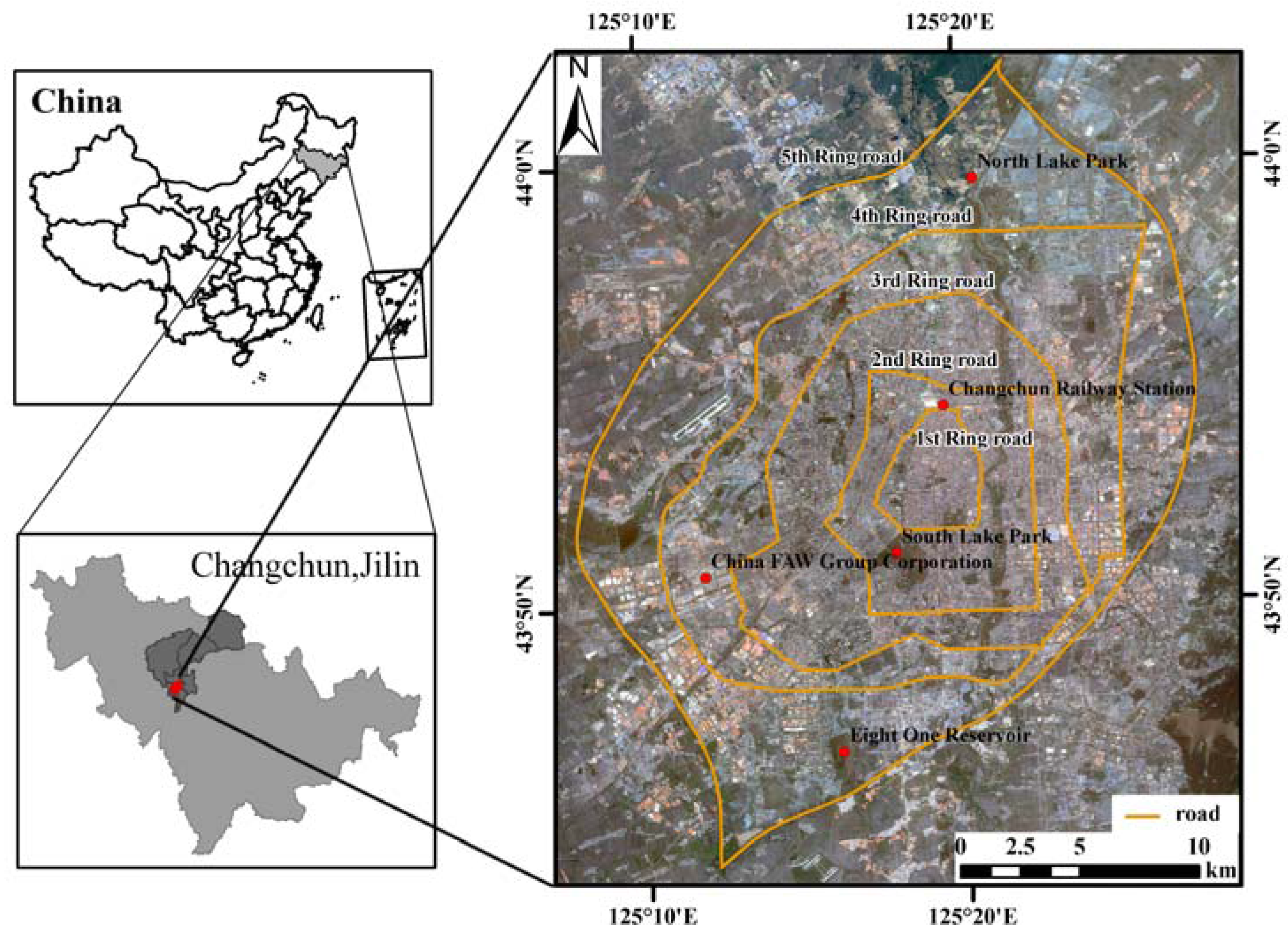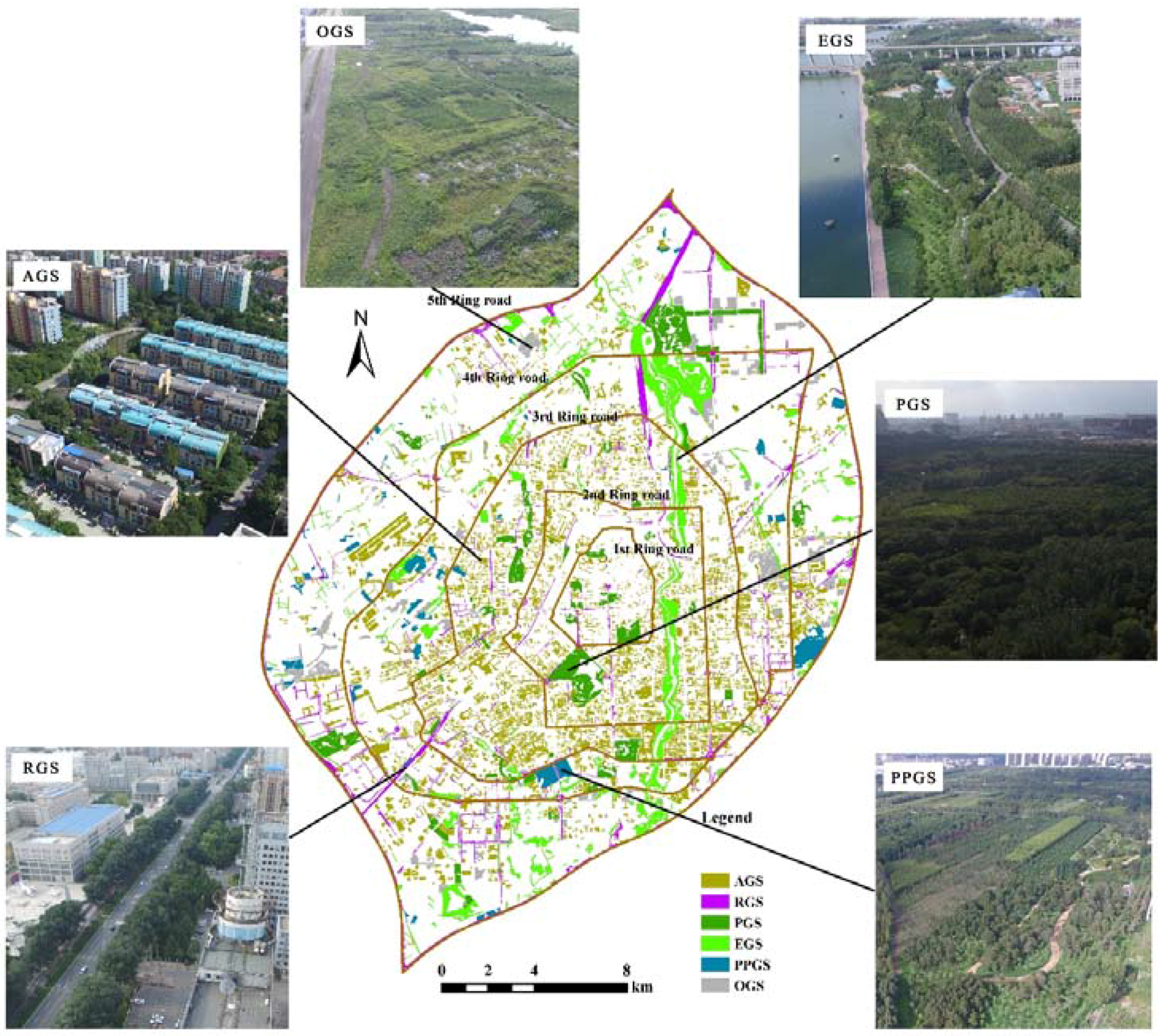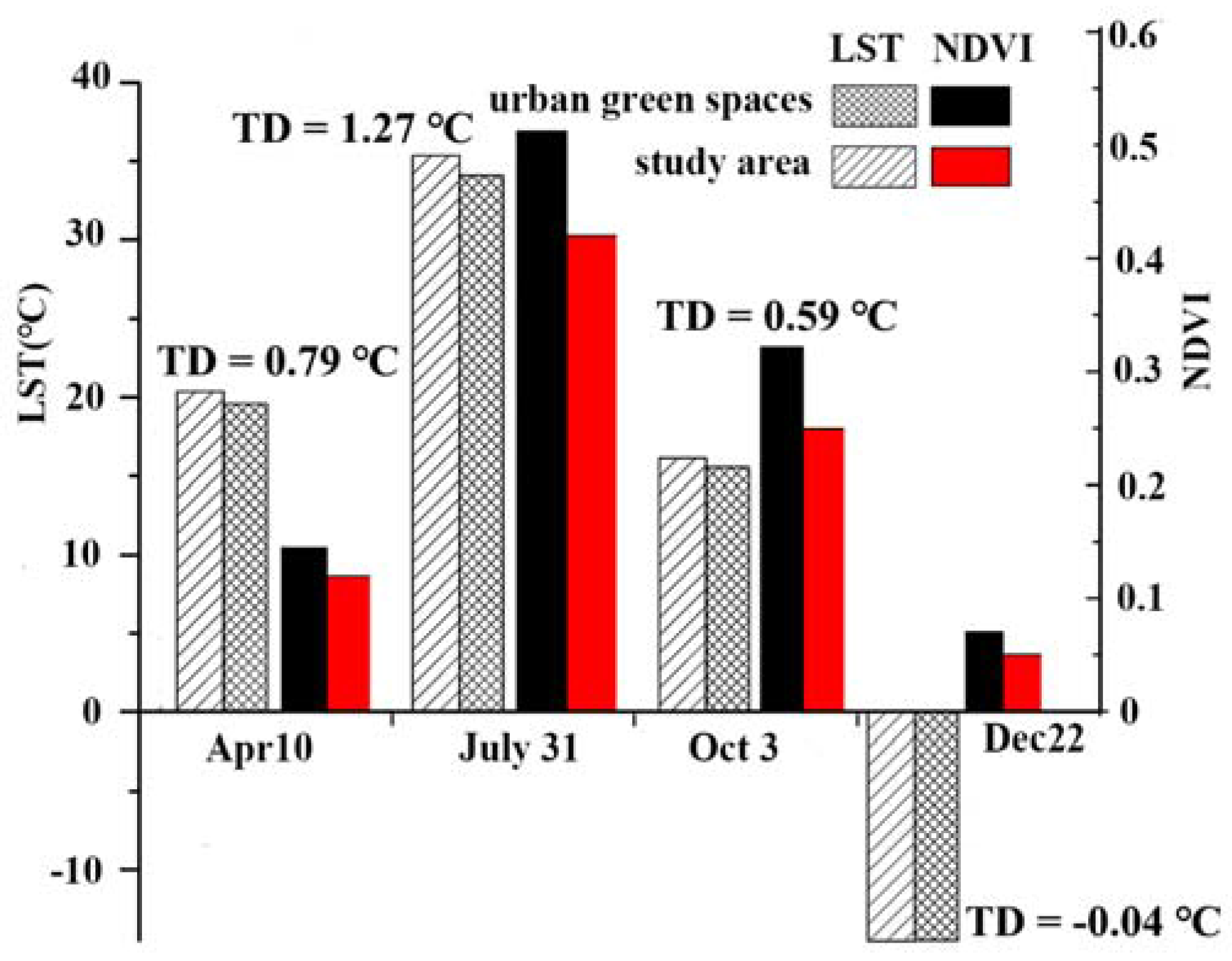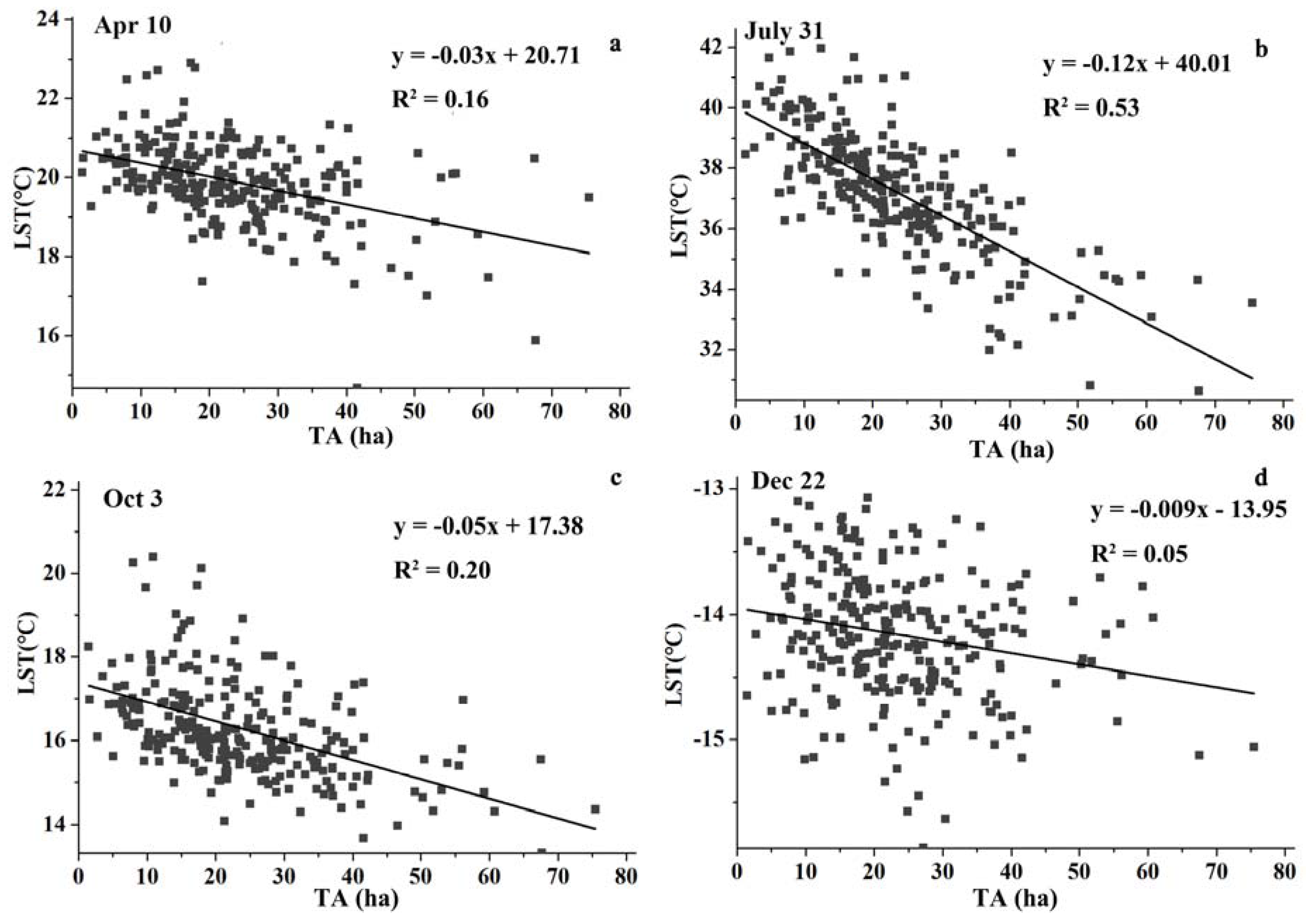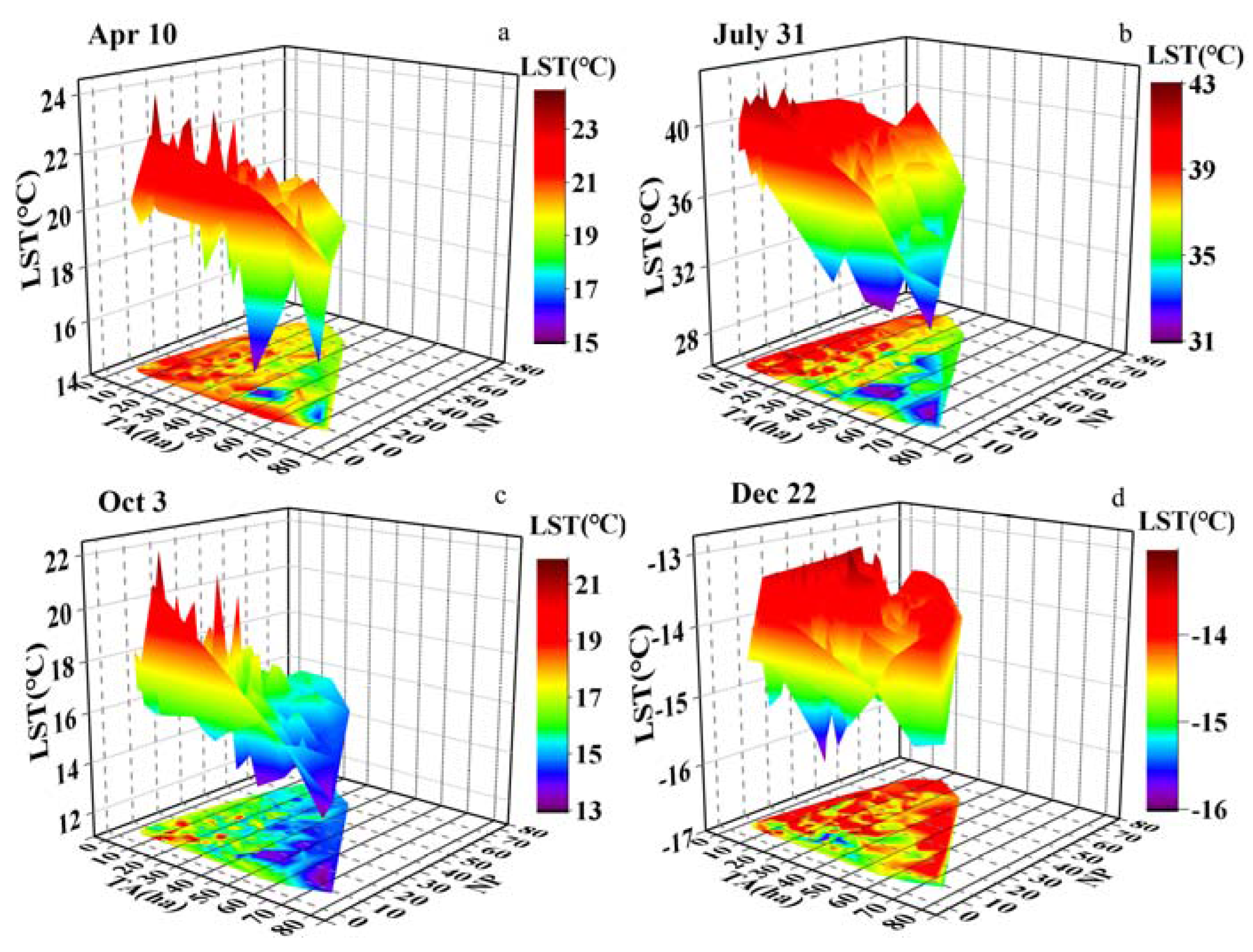1. Introduction
According to the United Nations, over half of the world’s population (54%) lived in urban areas in 2014, and this number is projected to increase to 66% by 2050 as a result of rapid urbanization [
1]. Therefore, more people will suffer from urban heat island (UHI) effects, which are caused by dramatic changes in land use and land cover, energy use, and air-pollutant emissions [
2,
3,
4]. Intensive heat can cause many negative effects, including significant health and well-being problems for urban inhabitants over the long term, and especially for the elderly [
5,
6,
7]. There is no doubt that understanding how to mitigate its negative impacts is one of the most important research issues for urban ecology and urban climatology.
Urban green spaces, such as open parks, forests, and grasslands, have been increasingly recognized as key components of urban planning [
8,
9,
10,
11]. Urban green spaces have been shown to form cool islands and improve outdoor thermal comfort throughout warm seasons, as well as significantly reduce environmental stress produced by heat island [
12,
13]. They can also provide critical ecosystem services that could improve residents’ health and wellbeing [
13,
14,
15]. Urban green spaces can cool climates through two major processes: shading and by providing higher evapotranspiration [
8,
16,
17]. As a result, over the past two decades, many studies have focused on understanding the effects of urban green spaces on the urban thermal environment [
11,
12,
17,
18,
19,
20,
21].
With the development of remote sensing technology, thermal infrared remote sensing and high resolution remote sensing images have been extensively utilized in urban climate and environment studies [
22,
23,
24]. Land surface temperature (LST) is a universal and important parameter for characterizing the urban thermal environment [
25,
26]. LST modulates the underlying urban air temperature and is a primary factor for determining surface radiation and human comfort [
27,
28]. At present, among the numerous data sources that are available, the Landsat series is most popular for retrieving LST for urban studies, as it has the advantage of higher spatial resolution (TM 120 m/ETM+ 60 m/Thermal Infrared Sensor (TIRS) resampled to 30 m) than Moderate Resolution Imaging Spectroradiometer (MODIS) and Advanced Very High Resolution Radiometer (AVHRR) [
29,
30,
31]. Advances in the datasets used to characterize land use allow researchers to better understand urban spatial patterns. Very high spatial resolution images, such as IKONOS and Quickbird, combined with thermal infrared images are widely used in urban ecology studies, making it possible to establish more accurate relationships between one single object and LST in finer scales [
32,
33,
34].
Moreover, the landscape ecology approach has been used to explore the relationships between urban green space patterns and the urban thermal environment [
32,
35,
36]. Many studies have determined that the size, shape, composition, spatial characteristics, and configuration of urban green patches have significant effects on the distribution of LST [
37,
38]. To characterize urban green space landscape patterns, two kinds of landscape metrics have been popularly used by scientists: landscape composition and landscape configuration [
39,
40]. Landscape composition metrics usually indicate the amount of area and type of land use, but do not provide any spatial information. In contrast, landscape configuration considers the geographic features of each land use type. Though increasing urban green spaces is an important strategy to mitigate UHI effects, metropolitan areas usually lack sufficient public spaces to create all of the urban green spaces that they need. Therefore, efficiently arranging urban green spaces within a fixed amount of available space has become increasingly more important because landscape configuration also affects radiative fluxes and energy flows [
41]. Many metrics have been developed to measure the effects of landscape patterns, such as area metrics, perimeter-area ratio, landscape shape index, and aggregation metrics [
29,
35,
42]. FRAGSTATS software (University of Massachusetts, Amherst, MA, USA) is widely used to calculate these metrics [
43].
Urban green spaces are diverse, with varying species compositions, functions, management policies, and many other aspects. Existing studies are essential for urban planning and sustainable development of urban environment, but more studies are needed within cold regions in particular to enrich the theory and the number of case studies available. Most studies explore the effect of urban green spaces on the urban environment in summer, while neglecting to study its effects during other seasons. The growth conditions of green spaces differ significantly in different seasons. As such, year-round study may provide a more comprehensive understanding of the mechanisms that affect how urban green spaces mitigate UHI effects. In addition, when using landscape approaches, often only one metric level is considered, especially at patch level or landscape level. The class level, however, is also important for understanding the effect of urban green spaces because different types have different contributions. Comparative approaches are needed to investigate the effect of urban green spaces at multiple different spatial scales rather than just one single scale which is the spatial resolution of the imagery data.
This paper aims to identify appropriate metrics that effectively describe the features of urban green spaces in order to investigate how different green spaces and their spatial configurations affect the urban thermal environments at different spatial scales across different seasons and to establish quantitative relationships between these aspects. To achieve our goals, very high spatial resolution imagery GF-1 (2-m spatial resolution) was utilized to obtain detailed information of urban green spaces, and Landsat 8 TIRS (30-m spatial resolution) was chosen to provide data on the urban thermal environment in spring, summer, autumn, and winter in Changchun, China.
4. Discussion
Representative landscape metrics at patch, class, and landscape level and quantitative statistical analysis were utilized to explore the effect of urban green spaces on the urban thermal environment. The results demonstrated that not only the composition of urban green spaces but also their configuration can significantly affect the distribution of the LST. The effect, however, varies greatly across different seasons depending considerably on the size and shape of urban green spaces, the status of vegetation, the analysis spatial scales, and seasonal radiation conditions. The results were consistent with many other previous studies, which demonstrated negative correlations between LST and urban green spaces [
3,
19,
54].
4.1. Implications for Methodology
First, comparative approaches with an additional cold zone case study were utilized in this study to investigate the relationship between urban green spaces and the urban thermal environment. Comparative approaches included a selection of landscape metrics at three levels, patch, class, and landscape level. The four dates representing spring, summer, autumn, and winter were chosen to explore seasonal variations; two spatial scales, 0.5 km × 0.5 km and 1 km × 1 km, were selected to study the relationship changes across scales. These helped generalize a more thorough scientific understanding of the effects of urban green spaces on LST.
Second, we propose that spatialization is an important part of landscape metrics. Traditionally, the result of landscape metrics calculated by metrics software, such as FRAGSTATS, is often shown in tables. In this study, with the help of ArcGIS 10.2, 2206 and 577 grids were created in the study area at the scale of 0.5 km × 0.5 km and 1 km × 1 km, respectively. Each grid was considered as a whole landscape, and landscape-level metrics were calculated for each grid. As a result, the spatial information of the metrics were presented as maps in order to show the distribution of metrics in a more explicit way.
4.2. Theoretical Implications
In this study, landscape metrics and NDVI were used to characterize the composition features of urban green spaces.
The negative relationship between urban green space areas (patch area, PA) and LST observed in this study is in agreement with previous studies [
55,
56,
57]. A higher percentage of cover of green spaces leads to lower LST, and its negative effects on LST is more significant in summer than for the other three seasons. This may be due to summer having the most heterogeneous thermal environment and higher evapotranspiration of vegetation. Compared to the area of urban green patches, the negative effect of PERIM on LST is much weaker, indicating that it may not be an ideal metric to present information of green spaces for this study. We found that shape metrics PARA and SHAPE, compared to area metrics (PA, TA), were not very valuable in all seasons for assessing their relationship with LST. Moreover, the results suggested that a significant cooling effect occurrs when the TA is beyond a certain threshold. For example, in summer at the 0.5 km × 0.5 km scale, the value is approximately 5 ha. Therefore, based on the results, increasing the area of urban green spaces can effectively mitigate the UHI, and this was consistent with previous studies [
38,
58].
NDVI is typically used as the indicator of vegetation abundance to estimate the LST-vegetation relationship [
21,
59]. The results indicated that high values of NDVI for urban green spaces led to significantly lower temperatures for all seasons except winter at class level. The negative relationship between LST and NDVI was much stronger than that of LST and the area of urban green spaces. High values of NDVI were usually related to a good grow status of vegetation or more green space density. This is a clear indication that the status of vegetation (e.g., tree species, vegetation cover percentage) plays a vital role in cooling the urban thermal environment. In winter, the urban green spaces have little effect on the urban thermal environment, confirming that the status of vegetation does matter for cooling intensity. Therefore, in an urban environment without enough public space for green vegetation, increasing the NDVI (for example, vegetation canopy cover) is still an effective way to decrease LST.
For different types of urban green spaces, PGS has a much lower temperature than the other types, while AGS and RGS usually have relative high temperatures. This may be due to several reasons: (1) the sizes of PGS sites were larger than other green space types, and there were more trees in parks; (2) the AGS patches were usually small and showed discrete distributions; and (3) the RGS sites were isolated and there were anthropogenic heat sources beside them, such as vehicles and buildings. As a result, by only considering the cooling intensity, if there is enough space, parks are a better choice than AGS and RGS for urban green infrastructure.
The whole study area was divided into small grids with a certain size, therefore the landscape-level metric NP rather than PD (patch density) was used to assess the spatial pattern of urban green spaces on LST. Our results showed that although the effect of the configuration of green spaces was not as strong as compositional features, it did play an important role in urban green space planning for regulating the micro-climate. For example, at the 1 km × 1 km scale, if a certain area of green space was to be arranged, how many patches should be considered? Our results showed that if the total area of green spaces was not large enough (approximately 20 ha in our case), the configuration has little influence. In summer, when the total area is larger than the threshold, for example, when the TA is between 20 and 30 ha in this study, with an increase in the number of patches, the LST tends to have few variations and even increases. However, when the patch number is larger than the threshold, the LST of the 1 km × 1 km grid will decrease significantly. Although when the TA is large enough on this scale, the NP has little effect on LST. As a result, the effects of NP on LST depends on the total area of urban green spaces and the season. Therefore, it still remains a challenge to assess how the NP can decrease LST in the most effective way. In addition, other landscape-level metrics, such as splitting index or connectance index could also be employed to investigate the effect of configuration in future studies. The splitting index is usually used to characterize landscape fragmentation in a geometric perspective and increases as the landscape is increasingly subdivided into smaller patches [
60]. The connectance index is used as the proportion of functional joinings among all patches, where each pair of patches is either connected or not based on some criterion [
43].
4.3. Limitations
This study has several limitations. First, only Landsat 8 TIR data were used to retrieve LST to characterize the spatial patterns of the urban thermal environment, thus the satellite overpass time was not synchronous with that of sparsely distributed meteorological stations. Due to the 30-m spatial resolution of TIRS data, the LST of some small green patches was influenced by surrounding urban areas. In addition, only one date was chosen to represent a season because there were insufficient daily or monthly images to meet the demand for retrieving LST. In addition, it is well known that different atmospheric conditions can affect the accuracy of the retrieved LST [
26]. However, these limitations were related to the difficulties in retrieving LST.
The second limitation is that bodies of water also play a very important role in cooling the LST [
37,
61]. For example, if bodies of water extensively exist in one analysis grid, the cooling effect of urban green spaces may be overestimated. However, the cooling effect of water was not considered in our study because we only sought to explore the effect of urban green spaces on thermal environments at the landscape level.
Finally, more attention is needed on the use of synchronous data from in-situ observations such as air temperature/humidity combined with high temporal resolution and long time span satellite data to have a better understanding of the cooling effect of urban green spaces produced by future studies. Researchers should interpret the results in comparison to previous studies and the working hypotheses. The findings and their implications should be further discussed in the broadest context possible, particularly to highlight future research directions.
5. Conclusions
Using Changchun, a cold temperate zone city, as a case study, this study investigated the effects of urban green spaces on urban thermal environments and their seasonal variations. With the support of multi-temporal Landsat OLI/TIRS images, high spatial resolution images GF-1, field data, and landscape ecology and comparative approaches were used to quantitatively examine the relationship between urban green spaces and LST. Our results showed the following:
- (1)
Urban green spaces have a significant cooling effect among all seasons except for winter, but the effects vary considerably among different seasons and green space types. The difference of LST between the urban green spaces and urban areas was large in the summer and small in the winter. The maximum value of the differences was 1.27 °C on 31 July. The lowest LST was found in PGS, while AGS and RGS have the highest LST among different green patches.
- (2)
Compared to shape metrics such as PARA and SHAPE, the negative relationships between LST and the area and NDVI of urban green spaces were more significant. We found that every 10% increase in urban green spaces explained a 0.34 °C decrease in LST in summer at the 0.5 km × 0.5 km scale. Rather than increasing the area of green patches, increasing the NDVI (more woodland area and denser vegetation) is a better and more practicable approach for urban green planning.
- (3)
Both the compositional features of urban green spaces and configuration can significantly affect LST. At certain spatial scales, for example, 1 km × 1 km, given a fixed area of urban green spaces, the number of green patches can increase or decrease the values of LST depending on if the number is larger than a threshold or not, and this threshold changes for each given area. For example, in our case, when the proportion of TA is between 20% and 40% in 100 ha, initially, the LST increases simultaneously with an increase in NP. When NP is larger than 40, however, the LST decreases.
This study has the potential to contribute to our understanding of how urban green spaces can mitigate urban heat island effects so that environmental problems may be resolved. The outcome of this study suggested that the process of cooling effects of urban green spaces differed among different seasons and green types, and it may provide insights for city planners and decision makers to forge sustainable urban strategies by considering the composition and configuration features of urban green spaces at the same time.
